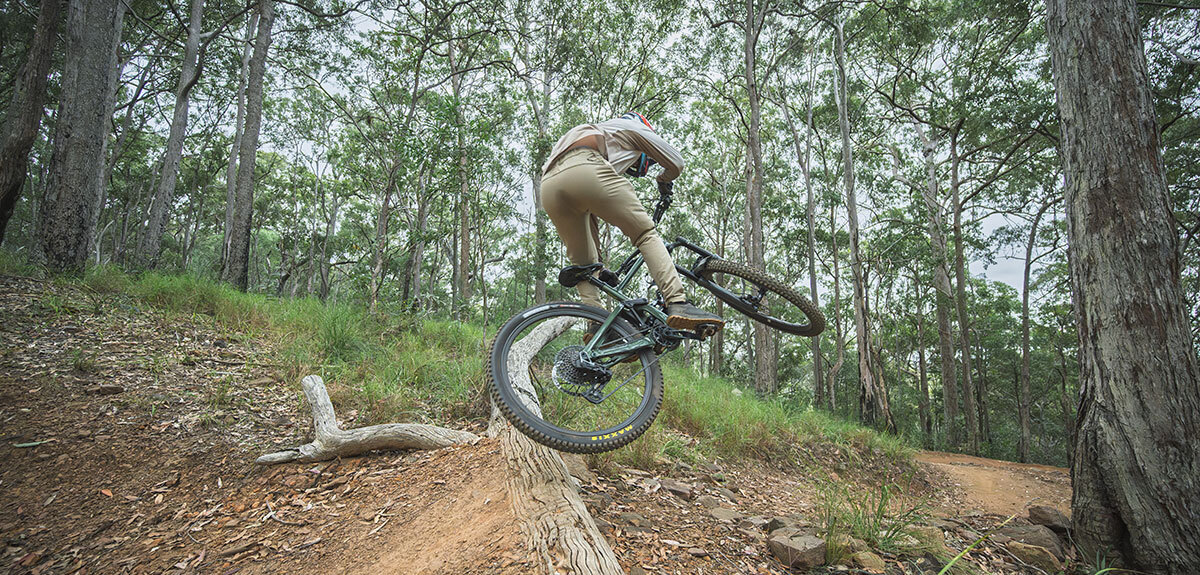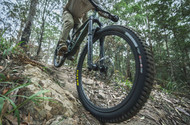Unravelling the Maxxis Mystery: Your Guide to Tyre Choices for Australian Trails
So, you've been smashing those trails, feeling the flow, and shralping every corner in sight. Now your tyres are worn out and it’s time to buy some freshies. But when it comes to tyres, you're probably seeing a heap of names and acronyms and wondering what on earth it all means. Don't stress, you're not alone!
Maxxis, in particular, offers an incredible range, and for good reason, your tyres are your critical connection to the ground and arguably the best value upgrade you can make to your bike. Selecting the right ones for your riding style and terrain is paramount.
Trails in Australia are very diverse from typical pea gravel loose over hard common in inland areas around the country, soft clay in north QLD, and loamy terrain found in Victroia and Tasmania, as well as rocky sandstone common on the coast in NSW.
We suggest speaking with your friends or people at your local trails for their suggestions, there’s always some nuggets of wisdom from locals when it comes to selecting tyres. However, we’ve developed this guide to sort through the jargon and find the best set up for your local.
Unpacking the Maxxis names
Even the most experienced and technically savvy mountain biker can get confused by the naming structure in Maxxis’ range. Let’s break it down for you:You might see a tyre named something like this:

The most important factors to consider are the model, casing type and rubber compound.
Casing Types: The Tyre's Backbone and Your Puncture Protection
The casing is the fabric structure of the tyre, and it dictates a lot about its durability, weight, and how it feels on the trail. Maxxis offers a few key options, each designed for a different kind of abuse (or lack thereof!).
With casing there is always a trade-off between weight and protection. A lighter tyre will feel nicer to ride uphill, and is also more supple which will help with rolling speed and comfort. However there is a trade-off with durability, so you should always avoid going too light for your trails/style/weight otherwise you will suffer from ‘snakebite’ punctures. This is where the tyre is pinched between your rim and a root or rock causing damage to the tyre. If you snakebite a tyre, it is often a total write-off (good-bye $100 brand new tyre! We’ve all been there)
|
Casing Name |
EXO |
EXO+ |
DoubleDown (DD) |
Downhill (DH) |
|
Description |
This is the lightest protection suitable for gravel, XC and trail riding, or lighter-weight riders. |
A step up in protection for more aggressive trail and enduro riding. |
The preferred choice for Enduro bikes and Bike Parks. |
The ultimate in toughness for gravity-focused riding. |
|
Construction |
Features an additional layer of a cut-resistant material added to the sidewalls, but nothing on the top of the tyre. |
Combines EXO protection with an additional layer of "SilkShield" bead-to-bead protection and a "butyl insert" around the bead for improved pinch flat resistance. |
Uses two full layers of casing material, reinforced with a butyl insert in the sidewall. It's basically a beefed-up version of EXO+. |
Features two layers of a tough 60 TPI casing, with a butyl insert for ultimate pinch flat protection and stability. |
|
Typical Weight |
Around 800-1000g |
A bit heavier than EXO, usually in the 950-1200g range. |
Noticeably heavier, often 1100-1300g+. |
The heaviest option, typically 1300g+. |
|
Suitable Terrain |
Great for general trail riding and XC. Think smoother XC trails and flow trails, but not necessarily super rough or rocky areas. Perfect for most XC trails across Australia such as Wylde MTB park in Sydney or XC epics like Thredbo Valley Track or the Indigo Epic. |
Fantastic for more aggressive trail riding, enduro races, and handling rougher, rockier terrain. Think the challenging sections of the Blue Derby trails or any XC trail in Sydney, with it’s famous tyre destroying sandstone. |
Built for aggressive enduro, bike park laps, and smoother downhill trails where durability and puncture protection are paramount. If you're riding anywhere with repeated rock gardens or fast speeds, we think DD tyres are the minimum. |
Specifically designed for downhill racing and the most extreme bike park riding. |
|
Riding Style |
Ideal for everyday riders, those who enjoy flowy trails, cross-country epics, and dabbling in a bit of everything without pushing the absolute limits of gravity. The supple casing provides noticeable improvement to rolling resistance, which can make all the difference on longer rides. |
For riders who push harder, take on chunkier trails, and want extra peace of mind against pinch flats and sidewall cuts without going full downhill monster. Suitable for weight-weenies looking to save some weight on their enduro bikes. You can often ‘get away with’ EXO+ on the front, while running DD on the rear. |
For racers, park rats, and those who prioritise maximum durability and support at high speeds and over rough terrain, sacrificing some weight for bombproof performance. That extra 100-200g weight saving of DD does improve climbing performance substantially. |
Dedicated downhill racers and gravity riders who demand the absolute best in puncture resistance, stability, and grip at high speeds on the most brutal terrain. If you are shuttling you should strongly consider DH casing. These are also often the preferred choice for rear tyres on Enduro bikes that are ridden in harder conditions. |
Compound Types: How Sticky is Your Rubber?
The compound is the rubber mixture itself, and it dictates how much grip you have, how fast the tyre rolls, and how long it lasts. As with everything, there’s a careful trade-off between grip, durability and price.
Maxxis has a few excellent options, however not every tyre is available in every compound type. Pure XC tyres (like the Aspen) will only be offered in 3C MaxxSpeed. Most tyres are available in 3C MaxxTerra. While only DH focused tyres are offered in 3C MaxxGrip (such as Assegai or DHR II). Dual Compound is also available in most tyres as a more budget friendly option.
|
Compound type |
Dual Compound |
MaxxSpeed (3C MaxxSpeed) |
MaxxTerra (3C MaxxTerra): |
MaxxGrip (3C MaxxGrip) |
|
Description |
Your entry-level, durable option. |
Designed for pure speed and efficiency, with some sacrifice to traction at the limit. |
The balanced performer for most riders in most conditions. |
Maximum stickiness for ultimate traction, at the cost of some durability. |
|
Grip/Rolling Resistance |
Harder rubber in the centre for durability and good rolling, softer on the shoulders for cornering. |
Low rolling resistance, as it uses the hardest compound for the centre tread. Good grip for XC racing. |
A good balance of grip and reasonable rolling resistance. Softer shoulder knobs for cornering bite, firmer centre for rolling. |
Extremely high grip, but with a noticeable increase in rolling resistance. The softest compound. |
|
Suitable Terrain |
General trail riding, XC, commuting. Good for less aggressive riding and where tyre longevity is a key factor. |
Cross-country racing, fast-rolling singletrack, and conditions where efficiency is king. |
Versatile across a wide range of conditions from dry, dusty Australian trails to loamy singletrack. Excellent for loose over hardpack and rocky sections. |
Ideal for wet, slippery, technical trails, aggressive downhill, and conditions where absolute grip is paramount. The soft rubber also performs significantly better in cold and wet conditions. |
|
Riding Style |
Recreational riders, XC enthusiasts, or those on a budget who want a reliable, long-lasting tyre for a variety of conditions. |
XC racers, marathon riders, and anyone who prioritises speed and efficiency on less technical terrain. |
Perfect for trail and enduro riders who want reliable grip without feeling overly slow on climbs. Suitable for use front and rear for a balanced feel. Some gravity focused riders will opt to run a MaxxTerra in the rear with a Maxxgrip tyre up front for a balance of grip, rolling resistance and durability. |
Downhill racers, enduro riders who prioritise outright grip, and anyone who wants maximum confidence in challenging conditions, especially as a front tyre. If the trails you ride have lots of hard rock (such as the granite rocks in Derby or Thredbo) you may notice premature wear from the Maxxgrip tyre as it tends to tear on hard surfaces. |
Popular Models: Matching Tyres to Your Trail Persona
Now let's talk about the specific tread patterns that Maxxis offers, each designed for different purposes.
We’ve ranked these options in order of popularity with our customers:
Maxxis Minion DHR II: The all-rounder
- Characteristics: Aggressive braking traction, solid climbing grip, reasonable rolling resistance and predictable cornering.
- Suitable Terrain: Excels on loose, technical climbs and steep descents. Handles diverse Australian conditions well. Australia’s favourite MTB tyre.
- Riding Style: Trail, Enduro and DH riders. Maxxis offer this tyre in a huge number of casing and compound types to suit every type of rider and terrain.
- Typical set ups:
- DHR II Front / Rear: Perfect Trail/Enduro all-rounder, a popular option for many riders.
- DHF Front / DHR II Rear: The classic trail set up for decent rolling speed and predictable handling. There’s not many places where this would be the ‘wrong’ choice.
- Assegai Front / DHR II Rear: DH and Enduro rider go-to. Suitable for elite level riders and casual riders. Predictable cornering performance, great braking and easy to shralp.
Maxxis Minion DHF: Hard charging trail tyre
- Characteristics: Excellent cornering grip, predictable feel, handles a wide range of conditions. Faster rolling than the DHR II or Assegai. Decent braking traction.
- Suitable Terrain: Loose over hardpack, loam, rocks, roots. Fantastic for Canberra trails like Majura or the varied terrain in Tasmania.
- Riding Style: While not as popular for DH use as it once was, this is still one of the go-to’s for trail and light enduro riding.
- Typical set ups:
- DHF Front / DHR II Rear: The classic trail set up for decent rolling speed and predictable handling. There’s not many places where this would be the ‘wrong’ choice.
- DHF Front / Rekon Rear: A good hard charging trail set up. Perfect for 120-140mm bikes and riders who climb fast and descend fast.
Maxxis Rekon: The fast-rolling XC and trail workhorse.
- Characteristics: Very fast rolling, good all-round grip for less aggressive terrain, reasonable braking.
- Suitable Terrain: Hardpack, loose over hardpack, flow trails, XC. Excellent for dry summer Australian conditions or if you prioritise speed and efficiency on less technical trails. Think Stromlo or Lysterfield trails.
- Riding Style: XC riders, marathon racers, or trail riders who want a fast-rolling set up that still inspires in the corners.
- Typical set ups:
- Rekon Front / Rear: Perfect for a 120mm trail bike on typical XC trails, especially if you prioritise up-hill performance.
- Dissector Front OR Forekaster Front / Rekon Rear: More of a shreddy XC set up, perfect for someone who charges up the climbs but doesn’t want to sacrifice on the descents.
- Rekon Front / Aspen OR Rekon Race Rear: The XC marathon choice. Great for XC racing where you want the fastest possible set up, but want to maintain some margin for error on the descents.
Maxxis Assegai: The ultimate grip machine for DH and Enduro
- Characteristics: Unbelievable grip in all conditions, very predictable, and confidence-inspiring. Rolls quite slow compared to DHR or DHF. Mostly suitable for a front tyre as it’s slow rolling and doesn’t perform well under braking on the rear.
- Suitable Terrain: Loose, wet, rocky, rooty – thrives in challenging conditions. Think the steep, tech trails such as World Cup at Bright or Cairns.
- Riding Style: DH and Enduro
- Typical set ups:
- Assegai Front / DHR II Rear: DH and Enduro rider go-to. Suitable for elite level riders and casual riders. Predictable cornering performance, great braking and easy to shralp.
- High Roller III Front / Assegai Rear: This is an emerging choice for some DH riders and has been popular recently on the elite DH circuit. Mostly suitable for very wet and steep trails.
Maxxis High Roller III: The Aggressive All-rounder
- Characteristics: Excellent grip, good braking, and predictable cornering, especially in loose or wet conditions. Rolls reasonably fast for its grip level.
- Suitable Terrain: Loose, loamy, and mixed conditions. Excels in wetter Australian trails, or areas with a lot of roots and rocks like parts of Tasmania or coastal NSW.
- Riding Style: Enduro and downhill riders, or people racing and seeking reliable grip in varied conditions.
- Typical set ups:
- High Roller III Front / Rear: A versatile set up for riders who want consistent grip on both ends, particularly in steep mountains or wet conditions
- High Roller III Front / DHR II Rear: A popular choice for a balance of front-end grip and slightly faster rolling in the rear.
- High Roller III Front / Assegai Rear: An emerging choice for DH riders on very wet and steep trails, offering maximum grip.

Maxxis Dissector: The Fast and Predictable Trail Tyre
- Characteristics: Designed to bridge the gap between aggressive trail tyres and faster rolling XC tyres. Offers good cornering bite, decent braking, and improved rolling speed.
- Suitable Terrain: Dry, loose over hardpack, and mixed trail conditions common across many Australian riding areas. Good for both flow trails and moderate tech.
- Riding Style: Trail riders looking for a balance of speed and grip, especially those who like to ride fast and drift corners controllably. Suitable for front or rear use.
- Typical set ups:
- Dissector Front / Rekon Rear: A popular setup for trail riders who prioritise climbing speed but still want confident descending performance.
- Dissector Front / Dissector Rear: A balanced choice for all-round trail riding, offering consistent feel.
- Dissector Front / Forekaster Rear: A shreddy XC setup for riders who charge climbs but don't want to sacrifice on descents.
- Assegai Front / Dissector Rear: DH and Enduro riders chasing a faster rolling option to the grippier and more aggressive DHR II rear.
Maxxis Rekon Race: The XC Race Machine
- Characteristics: Extremely fast-rolling with minimal tread for maximum efficiency. Offers predictable handling for a race tire, but less aggressive grip than other models.
- Suitable Terrain: Hardpack, groomed XC race tracks, and dry, fast-rolling trails. Ideal for the smoother XC trails found at venues like Stromlo Forest Park.
- Riding Style: Cross-country racers, marathon riders, and those who prioritize outright speed and minimal rolling resistance above all else.
- Typical set ups:
- Rekon Race Front / Rekon Race Rear OR Aspen Rear: The ultimate XC race setup for dry, fast courses where every watt counts.
- Rekon Front / Rekon Race Rear: A common XC marathon choice, offering a slightly more forgiving front tire with the speed of the Rekon Race in the rear.
Maxxis Ikon: The Everyday XC Champion
- Characteristics: A high-volume, lightweight XC tire known for its versatility and predictable grip across a range of less aggressive terrain. Fast-rolling with decent braking.
- Suitable Terrain: Hardpack, loose over hardpack, and general cross-country trails. A great choice for daily riding on typical Australian XC trails.
- Riding Style: XC riders, marathon enthusiasts, and recreational riders who want a reliable, fast-rolling tire that handles diverse conditions without being overly aggressive.
- Typical set ups:
- Ikon Front / Ikon Rear: A classic, fast-rolling XC setup for general trail riding and endurance events.
- Dissector Front / Ikon Rear: Offers slightly more front-end grip for those seeking a bit more confidence on descents while maintaining a fast-rolling rear.


